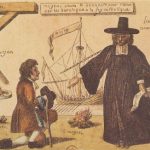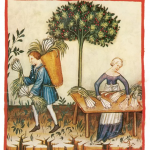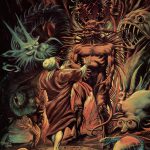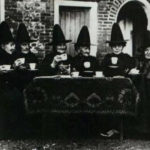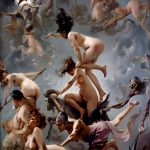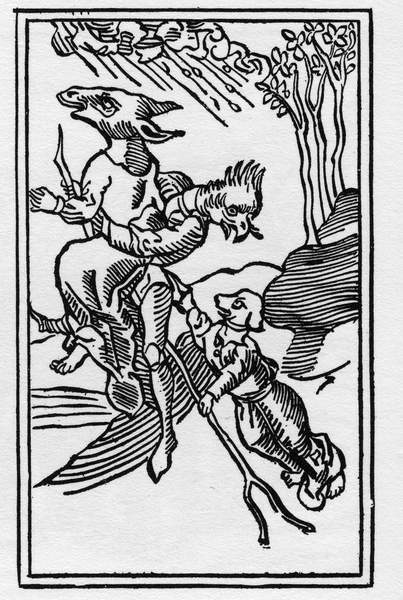
The witch flying on a broomstick has become the archetype for magic and witchcraft in the Western world. Integral to this archetype is the often overlooked flying ointment. Also known as transvection, the earliest depiction is Ulrich Molitor’s engraving in De Lamiis (1489). It shows three Witches, each with an animal’s head, each astride a long, forked branch.
The use by witches of flying ointments was first described, according to known sources, by Johannes Hartlieb in 1456. It was also described by the Spanish theologian Alfonso Tostado (d. 1455) in Super Genesis Commentaria (printed in Venice, 1507), whose commentary tended to accredit the thesis of the reality of the Witches’ Sabbath.
In 1477 Antone Rose confessed that the devil gave her a stick 18 inches in length on which she would rub an ointment and with the words “go, in the name of the Devil, go” would fly to the “synagogue” (an alternative name for Sabbath in early witchcraft).
However, from as early as the ninth century, there has been skepticism regarding Witches’ ability to fly. The Canon Episcopi, of c. 900 CE, stated that Witches did not have the power to fly through the air, nor to turn themselves into birds and animals.
Some wicked women, perverted by the Devil, seduced by illusions and phantasms of demons, believe and profess themselves, in the hours of the night, to ride upon certain beasts with Diana, the goddess of pagans, and an innumerable multitude of women, and in the silence of the dead of night to traverse great spaces of earth, and to obey her commands as of their mistress, and to be summoned to her service on certain nights. . . . For an innumerable multitude, deceived by this false opinion, believe this to be true, and so believing, wander from the right faith and are involved in the error of the pagans when they think that there is anything of divinity or power except the one God.
In The Book of Sacred Magic of Abra-Melin, there is the following passage about in event that supposedly happened to the mage in 1458.
At Lintz I worked with a young woman, who one evening invited me to go with her, assuring me that without any risk she would conduct me to a place where I greatly desired to find myself. I allowed myself to be persuaded by her promises. She then gave unto me an unguent, with which I rubbed the principal pulses of my feet and hands; the which she did also; and at first it appeared to me that I was flying in the air in the place which I wished, and which I had in no way mentioned to her. . . . Appearing to myself to have remained there a long while, I felt as if I were just awakening from a profound sleep, and I had great pain in my head and deep melancholy. I turned round and saw that she was seated at my side. She began to recount to me what she had seen, but that which I had seen was entirely different. I was, however, much astonished, because it appeared to me as if I had been really and corporeally in the place, and there in reality to have seen that which had happened.
He concluded the unguent induced hallucinations of flying and other fantasies (Lois Martin, A Brief History of Witchcraft, pp. 49-50).
Dominican churchman Bartolomeo Spina gives two accounts of the power of the flying ointment in his Tractatus de strigibus sive maleficis (‘Treatise on witches or evildoers’) of 1525. The second concerns a certain notary of Lugano who, unable to find his wife one morning, searched for her all over their estate and finally discovered her lying deeply unconscious, naked and filthy with her vagina exposed, in a corner of the pigsty. The notary ‘immediately understood that she was a witch’ (!) and at first wanted to kill her on the spot, but, thinking better of such rashness, waited until she recovered from her stupor, in order to question her. Terrified by his wrath, the poor woman fell to her knees and confessed that during the night she had ‘been on a journey’.
However, later Christian inquisitors decided to ignore this and admit flying as evidence of a Witch being in league with the Devil. In addition, a large number of those accused of witchcraft did claim under torture to have rubbed their bodies with ointment and flown through the air.
In the Malleus Maleficarum, the infamous book of instructions produced by the two German monks, Heinrich Kramer and Jakob Sprenger, which became the bible of the majority of judges at the Witch trials:
It must not be said that witches cannot be locally transported because God does not permit it. For if He permits it in the case of the just and innocent, and of other Magicians, how should He not in the case of those who are totally dedicated to the devil? And we say with all reverence: Did not the devil take up Our Saviour, and carry Him up to a high place, as the Gospel testifies? . . . Now the following is the method of being transported. They take the unguent which, as we have said, they make at the devil’s instruction from the limbs of children, particularly of those whom they have killed before baptism, and anoint with it a chair or a broomstick; whereupon they are immediately carried up into the air, either by day or by night, and either visibly or, if they wish, invisibly; for the devil can conceal a body by the interposition of some other substance.
Records of the trial of the Somerset Witches, in 1664, contain reference to the use of flying ointment. According to one of the accused, Elisabeth Style, they all anointed themselves with a greenish ointment given to them by their Chief, an unknown man dressed all in black. Style said that after anointing themselves they would fly while saying the words: “Thout, tout a tout, tout, throughout and about.” On their return journey they cried, “Rentum Tormentum.”
In 1963 Gerald Gardner’s High Priestess, the Lady Olwen, managed to make ointment following an old recipe from the Book of Shadows. The ingredients included aconite, cinquefoil, foxglove, and poppy juice.
She and I rubbed a little on our wrists, inside elbows, armpits, backs of the knees, and ankles. We were sitting in front of a fire, as was prescribed, and in a very short time both of us felt a sensation of rising up off the ground and floating in the air. This continued for a while before we returned to normalcy.
Olwen stated that one of her other Witches, when trying the ointment, had sworn she floated outside the house and onto the front lawn. It would seem, then, that it is indeed the potency of the ingredients that gives one the illusion of flying. Gerald Gardner suggested that originally the ointment was rubbed on the body simply as protection from the cold when traveling skyclad to a sabbat. The potent ingredients then persuaded the Witch that she had actually flown to the meeting place.
Recipes
Recipes for the witches’ flying ointment can be found in works of 16th century physicians/scholars Jerome Cardan and Giovanni Battista della Porta, in which the fat of infants is mixed with many various ingredients, including herbs known to have hallucinogenic and paralyzing effects, deadly nightshade and aconitum.
The book of the latter, Magia Naturalis, appeared in 1558 and included a section on flying unguents (Lamiarum Unguenta). His knowledge of such matters was called to question by the Church, and he was summoned before Pope Paul V to explain about Witches’ flying ointments and the necromantic arts.
In 1428, accused with Matteuccia di Francesco was reported to have said that witches’ flying ointments consisted of bat blood, vulture fat, and the bloodof a newborn baby. Eight years later, Johannes Nider wrote in the Formicarius that boiled, unbaptized babies were the central ingredient.
Reginald Scot, in his Discoverie of Witchcraft (1584), details how the “bowels and members” of children, similarly dug up out of their graves, are fast boiled in a cauldron and the thickest of the resulting grease is used for the flying ointment. Scot, however, did not believe that Witches really did fly, with or without this ointment.
Francis Bacon (attributed as “Lord Verulam”), in Sylva Sylvarum (1608), gives a list of ingredients for the flying ointment:
The ointment that witches use is reported to be made of the fat of children digged out of their graves; of the juices of smallage, wolf-bane, and cinque-foil, mingled with the meal of fine wheat. But I suppose that the soporiferous medicines are likest to do it; which are henbane, hemlock, mandrake, moonshade, tobacco, opium, saffron, poplar-leaves, &c.
So why the fat of infants? According to pharmacological studies, mixing the flying concoction with fat allowed it to become an ointment that could be absorbed into the skin. The use of infants, and more specifically, unbaptized infants, was based on the belief that before baptism, the soul of the child is in limbo and not yet protected by the Church. In the popular psyche, witches took on a significant role in obtaining infants for this purpose.
Explanation
Flying ointments were made of hallucinogenic and often toxic herbs such as Belladonna, Aconite, Mandrake Root, Hemlock, Datura, Opium Poppy, and Henbane.
These herbs were either infused in an oil base, strained, or added to lard. The witches then applied these ointments on their bodies for a hallucinogenic “flying” experience.
Most of the herbs used in flying ointments are from the Solanaceae botanical family, more commonly known as the Nightshade family and the non-toxic varieties (Mugwort and Wormwood) are from the Asteraceae botanical family.
Belladonna, Datura, Henbane, and Mandrake Root all have tropane alkaloids: atropine, hyoscyamine, or scopolamine. These are the chemicals that produce their psychoactive, sedative, and pain relieving effects. Scopolamine can cause psychotropic effects when absorbed transdermally.
Entheogens have been used by Indigenous people for thousands of years for spiritual purposes. Such as the case with Ayahuasca which is a botanical brew made with different entheogenic plants and is used by the Indigenous people of the Amazon region for spiritual purposes. It is important to note that the use of entheogens is sacred to many indigenous cultures and were a part of their spiritual practices.
Today young westerners in search for a psychedelic experience would turn to Ayahuasca, certain mushrooms, and of course drugs like LSD and ecstasy. The knowledge of our ancestors, part of which was transmitted orally between women, got irremediably lost with the burning times.
NB: These recipes include toxic plants and should not be prepared or administered to anyone.
Traditional English Flying Ointment from Erica Jong’s Witches
3 grams annamthol
30 grams betel
50 grams extract of opium
6 grams cinquefoil
15 grams henbane
15 grams belladonna
15 grams hemlock
250 grams cannabis Indica
5 grams canthreidin
Blend with oil of your choice, baby fat, vaseline, safflower oil, or butter.
Book of Shadows
One recipe for a traditional English flying ointment, found in the Gardnerian Book of Shadows, is as follows:
Lard—100 gram,
Hashish (first quality)—5 grams,
Hemp flower—a handful,
Poppy flower—a handful,
Powdered Hellbore Root—a pinch,
Ground Sunflower Seed—a pinch.
To be rubbed into the skin behind the ears, on the neck along the line of the carotid arteries, in the armpits, to the left of the sympathetic nerve, in the back of the knees, on the soles of the feet, and in the bend of the arms. After application, subject should sleep naked in front of a fire, or a statue of the Goddess.
Another recipe from the Book of Shadows:
3 grams annamthol
50 grams extract of opium
30 grams extract of betel
6 grams cinquefoil
15 grams henbane
15 grams belladonna
15 grams hemlock,
250 grams Indian Hemp (Cannabis Indica)
5 grams cantharides
Gum tragacanth
Powdered sugar
Blend with any oil, such as pure olive oil, or mix in with creme, such as lanoline. For external use only; not to be taken internally; extremely dangerous.
In an appendix to Murray’s The Witch-Cult in Western Europe, A. J. Clark gives three French recipes:
Parsley, water of aconite, poplar leaves, and soot.
Water parsnip, sweet flag, cinquefoil, bat’s blood, deadly nightshade, and oil.
Baby’s fat, juice of water parsnip, aconite, cinquefoil, deadly nightshade, and soot.
The soot was probably added merely to make it more difficult to see the Witch traveling in the night. The baby’s fat (or perhaps pig’s fat) is simply a base or carrier, and the bat’s blood would seem to be an inert ingredient. But from the use of the aconite, belladonna, and hemlock, there can be no doubt about the efficacy of this unguent.
Modern American Flying Ointment
1 jar hand cream
1 tsp. vegetable fat
1/2 tsp. belladonna
3 drops liquid detergent
1/2 tsp. wolfbane juice
Mix well with perfume of your choosing
French Flying Ointments : Three Recipes
I. Du persil, de l’eau de l’Aconite, des feuiles de Peuple, et de la suye.
(Parsley, essence of aconite, poplar leaves and soot.)
II. De la Berle, de l’Acorum vulgaire, de la Quintafeuille, du sang de chauvesouris, de la Morelle edormante, et de l’huyle.
(Water parsnip, sweet flag, cinquefoil, bat’s blood, deadly nightshade, and oil.)
III. De graisse d’enfant, de suc d’ Ache, d’Aconite, de Quintefeuille, de Morelle, et du suye.
(Baby’s fat, juice of the water parsnip, aconite, cinquefoil, deadly nightshade, and soot.)
Modern Wicca Flying Ointment Beeswax Base Recipe
4c. Standard Beeswax Base
1/4c. skullcap
1/2c. jasmine flowers
1/2c. lavender flowers
1/4c. hawthorn berries
1/3c. elderberries
1/4c. elderflowers
1/2c. mistletoe
1/3c. mugwort
1/4c. rue
20 drops of the pure essential oil of myrtle
20 drops of the pure essential oil of hops
10 drops of the pure essential oil of linden (careful! often adulterated!)
10 drops of the pure essential oil of clary sage
10mL of a 5% dilution of narcissus in grapeseed oil

